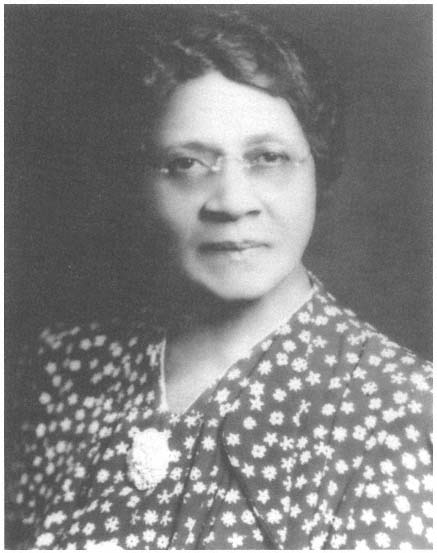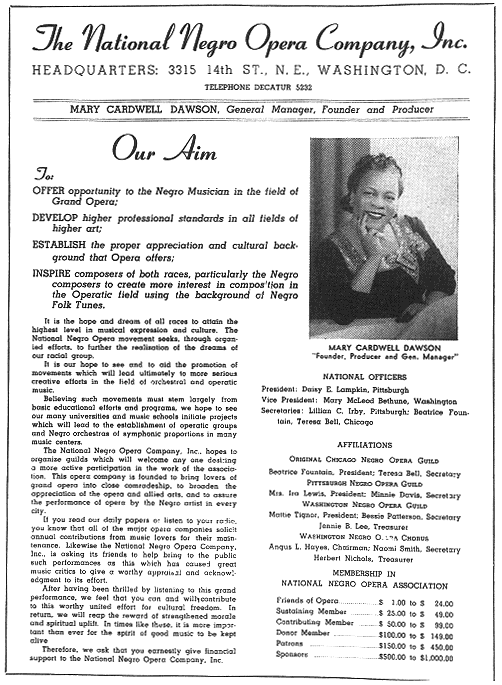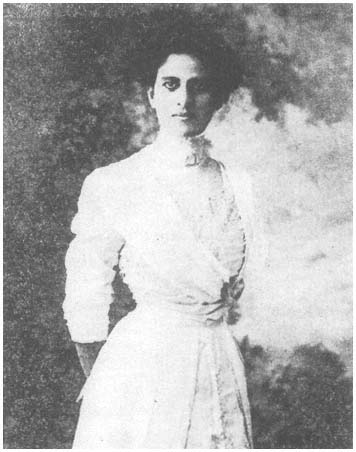Founders of Institutions
Although college-level training in music was available to African-American students at historically black colleges and universities, as well as at some predominantly white music schools, such as Oberlin Conservatory and the New England Conservatory, the need for easily obtainable training in music beyond high school was often met by small local institutions. Several music schools or departments of music within schools were founded by black women during the years 1903 to 1930;[34] moreover, many music studios (sometimes called schools) were established by performers after retiring from the stage. Of the several women who founded institutions, Harriet G. Marshall (1869–1941), Lulu Vere Childers (1870–1946), Emma Azalia Hackley (1867–1922), and Mary Cardwell Dawson (1894–1962) stand tall because of the unusual nature of their contributions.
Most impressive among institutions established by black women was the Washington Conservatory of Music and School of Expression founded in Washington, D.C., by Harriet Gibbs Marshall.[35] Marshall was the first of her race to graduate from the Oberlin Conservatory of Music as a piano major, and, after piano study in Europe, she concertized in the United States. She established a department of music (ca. 1890) at Eckstein-Norton, a small black college in Cane Spring, Kentucky, and raised money for the music building through her piano concerts and through performances of the Eckstein-Norton Choir, a group she organized and directed.[36]
Marshall's most remarkable contributions, however, were made in connection with the Washington Conservatory. Her experience at Eckstein-Norton convinced her of the need to find and train talented youth and inspired Marshall to open her school in 1903.[37] It was more widely known than other private schools owned and operated by blacks and, by offering conservatory-level instruction, attracted students mainly from Washington but also from the North, South, and Midwest. It was also the longest to survive, although not without tremendous effort on Marshall's part. In order to keep the school financially afloat, she wrote voluminously for assistance to politicians, artists, and any others whom she considered possible donors.[38] Although there was never a surplus of money on hand, the school continued to operate until 1960 with assistance from white as well as black philanthropists.[39]
From its beginning, the Washington Conservatory recruited a faculty of highly trained, and, in some cases, widely known musicians. Emma Azalia Hackley, whose later achievements as singer, conductor, and educator are discussed below, commuted from Philadelphia to teach at the conservatory during the 1903–4 academic year. Her response to the invitation to teach at the school was probably representative: "I would enjoy very much the association with you and other persons mentioned as the faculty-to-be. In a kind of faint far-off way, we have nursed a
somewhat similar idea here, but we are not so blessed with talent as is Washington."[40]
Throughout her career, Marshall was fortunate in that she was encouraged by her father, Judge Wistar Mifflin Gibbs. He contributed the building in which the school was housed, and in his letters he assured her of his support for whatever decisions she made.[41] Although she received assistance from many donors, and endorsements from prominent black musicians such as the composer Florence Price,[42] some questioned the need for the school. Henry C. King, president of Oberlin, spoke of his initial reservations, "The question . . . was whether with the musical department of Howard University, there really was any such demand for another school [in Washington]." He did finally give Marshall his endorsement, commenting, "I am glad to send you a word that I hope may be of help to you in building up your work. You certainly seem already to have developed quite an institution."[43]
In addition to the meritorious service of providing music instruction to many students, the Washington Conservatory of Music offered the Washington community a concert series that annually presented artists of national stature. As discussed earlier, the most widespread institutional support of the black concert artist came from the churches, which had since the early nineteenth century assumed the management and promotion functions of concert bureaus. Increasingly, black colleges began to sponsor musical programs, and the larger institutions such as Fisk, Hampton, and Howard sponsored annual concert series for the enjoyment of the students and the wider African-American community. At the same time, these series (whether in churches or colleges) were crucial to black performers, who in the early twentieth century, especially as they began their careers, were dependent upon this "black circuit" for performance opportunities.
An 1896 graduate of Oberlin Conservatory, Lulu Vere Childers came to Washington to join the faculty of Howard University in 1905. She was responsible for turning a small music program into, first, a Conservatory of Music (1913) and, later, into a School of Music (1918). When Howard offered its lecture-recital series in the 1920s, the young singer Marian Anderson, a friend of Childers', was among the artists. As the years passed, the series assumed an important position in Washington music affairs. Concerts by artists of national and international standing drew racially mixed audiences, an anomaly in the segregated city, and were prominently reviewed in newspapers of both black and white communities. In preparation for the 1938–39 season, Constitution Hall was sought as a larger auditorium for a recital by that same Marian Anderson, who was by now a world-renowned contralto. This request set in motion events that led to the great singer's triumphant Lincoln Memorial concert of April 1939, the result of the Daughters of the American Revolution's refusal to rent Constitution Hall for a performance by a black artist.
In view of the fact that college choir directors among women were relatively few, the achievements of Childers in this regard are particularly noteworthy. She won favorable criticism for presentations of choral masterpieces such as Handel's Messiah ,
Fig. 21.
Lulu Vere Childers, choral conductor and longtime dean of the School of Music, Howard University.
Photograph possibly taken upon her receiving the honorary doctorate in music, 1942.
By permission of the Moorland-Spingarn Research Center, Howard University
Archives, Howard University.
Mendelssohn's Elijah , Gabriel Pierné's The Children's Crusade , and Samuel Coleridge-Taylor's Hiawatha trilogy. Vespers services featuring the choir brought overflow audiences to the University Chapel, especially at Easter and Christmas.[44] The Department of Music at Howard University must be viewed as Childers' legacy.
Emma Azalia Hackley's wide-ranging musical activities, which included teaching voice, lecturing, and performing, seemed to be equal components in her struggle to assist young black performers. She believed that "there is a future for colored musicians. . . . If we encourage our young people generally throughout the country every five or six years some one of them will leap out of the circle of mediocrity and push his way to the front, and perhaps represent us musically as we have never been represented."[45] She, too, founded a music school, the Vocal Normal Institute of Detroit, Michigan, which existed from 1912 to 1916. After a trip to Paris to study voice, she conceived the idea of sending students to study abroad and raised money for scholarships through her own concerts and donations from patrons. She could point to several outstanding musicians whom she had helped. Clarence Cameron White (1880–1960), a violinist who became a celebrated black composer, was the first beneficiary. His $600.00 scholarship was, in Hackley's words, "a mere pittance [but still helpful] if it would score one point in favor of so many millions of people" (i.e., black Americans).[46] White used the money to study in London with Samuel Coleridge-Taylor. Foremost among recipients of the Hackley scholarship awards was another composer of national standing, R. Nathaniel Dett (1882–1943), also a pianist. The singers Cleota Collins (1893–1976) and Florence Cole Talbert and the violinists Harrison Emmanuel (dates unknown) and Kemper Harreld (1885–1971) also received assistance for study from Hackley. Carl R. Diton (1886–1962), who used his Hackley scholarship to study piano in Munich, Germany, spoke of the large number of black singers who profited from Hackley's educational activism, "She more than anyone else is responsible for the trend toward the cultivation of the Negro's natural voice and higher musical training. . . . No other Negro to my knowledge has given her time, money, and energy in this way, unselfishly and purely for the sake of the other individual."[47]
Training a young performer was not, of course, enough. Black educators must have found it galling that even their best students could find few professional opportunities. Black singers, for example, were systematically excluded from performing with white opera companies in the United States; Lillian Evanti (1890–1967) and Caterina Jarboro (1903–86), though, did sing with established companies in Europe.[48] At the turn of the century, a few singers found opportunities to perform with black traveling companies that introduced operatic finales into their shows.[49]
To counteract this state of affairs, which existed until 1955, when Marian Anderson made her belated appearance at New York's Metropolitan Opera as Ulrica in Verdi's Un ballo in maschera , black opera companies were formed. These companies, most of them episodic and short-lived, began staging opera with black casts in the 1870s.[50]
Mary Cardwell Dawson (1894–1962) accepted the challenge and established
Fig. 22.
Call for contributions (in a [1940s?] program for Aida ), National
Negro Opera Company, Inc., founded by Mary Cardwell Dawson.
Louia Vaughn Jones scrapbooks, Moorland-Spingarn Research
Center, Howard University.
the National Negro Opera Company (NNOC) in 1941. An activist teacher when she founded the Cardwell School of Music in Pittsburgh in 1927, Dawson had become aware of the desperate need of the black singer for an operatic outlet. Her company lasted for twenty-one years, mounting productions of operas and oratorios, and presenting some of the best-known black singers. One of its most successful productions was La traviata presented in 1943 in Washington, D.C., with Lillian Evanti singing the lead role. The production was heard initially by an audience of 15,000 and, to accommodate others who wished to hear it, was scheduled for a repeat performance.[51] The favorable critical review of the production must have brought well-deserved professional satisfaction to the prima donna, Lillian Evanti, and also to the far-sighted Mary Cardwell Dawson.
Fig. 23.
Maud Cuney-Hare.
By permission of Atlanta University Center, Robert W. Woodruff
Library.


